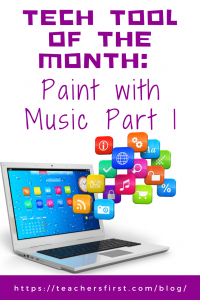Can you imagine if you could hear what you’re painting? Treat your senses to Google Arts & Culture: Paint with Music, an experiment offered by Google that connects two forms of art expression: musical composition and painting. This neat experience offers four different canvases that allow you to translate your painted brushstrokes into music. Choose from flute, violin, saxophone, and trumpet sounds. Next, paint on landscapes inspired by the ocean, the street, the sky, or decorated paper. You can click to add lines for the heptatonic or Hirajoshi scales and add decorative stamps. When finished, share your musical masterpiece by URL, through Google Classroom, or using various social media platforms.
Applying the Triple E Framework
The Triple E Framework, created by Dr. Liz Kolb, maintains that “effective technology integration begins with good instructional strategies and not fancy tools” (tripleeframework.com). Dr. Kolb wrote a book on the topic, Learning First, Technology Second (ISTE, 2017), that lays out the three main uses for technology in education: to Engage, Enhance, or Extend learning goals. We can use this framework to decipher why we use specific classroom tools. Here is a rubric based on the Triple E Framework you can use to evaluate whether Google Arts & Culture: Paint with Music (or any other technology) is a good fit with your learning goals and whether you should use it in your lesson.
- Engage in learning goals: Students become active, social learners as they create brush strokes and listen to the music. The stamps, sounds, and artwork make the tool more engaging, motivating students to begin the learning process. Students focus more on the task because they are creating their own experience on this site.
- Enhance learning goals: Google Arts & Culture: Paint with Music allows students to demonstrate a more sophisticated understanding of music composition and instruments by creating the learning experience and sounds. Students can also use this tool to create a path to demonstrate their knowledge in a way that they cannot do without technology (creating art that can be shown through music).
- Extend learning goals: Dr. Kolb describes extended learning as an opportunity for students to learn, connect, and collaborate outside the regular school day and to bridge the school day and real-life experiences. This art and music experience could be completed as a remote, flipped, or blended learning activity and would make an ideal asynchronous learning experience.
SAMR Connection
The SAMR Model, by Dr. Ruben Puentedura, suggests that technology implementation has four levels. Therefore, we can use this model as a guideline to analyze how we use technology tools in the classroom. For example, Google Arts & Culture: Paint with Music can be used at the modification and redefinition levels, depending on what the student is doing.
- Modification: The level of modification allows us to make (or modify) the activity into something more integrated with technology, meaning there is significant task redesign. Students can create music using a virtual paintbrush—this is something that could not be completed without technology.
- Redefinition: At the highest level, the technology allows for the creation of new, previously inconceivable tasks. Students using Google Arts & Culture: Paint with Music can reach the redefinition level by sharing their musical creations with their peers through Google Classroom or one of the other sharing options.
Don’t miss Part 2 of the Tech Tool of the Month: Google Arts & Culture: Paint with Music, where we’ll discuss how to use the tool and classroom implementation ideas. In the meantime, let us know how you have used Google Arts & Culture: Paint with Music in your education setting in the comment section below.


